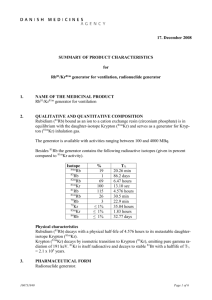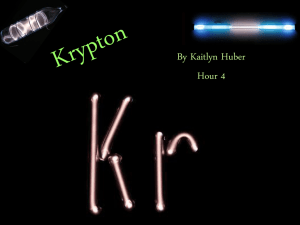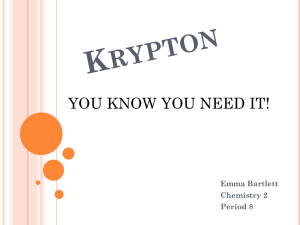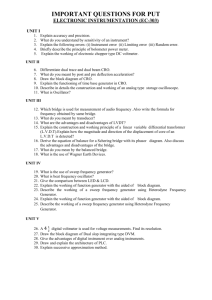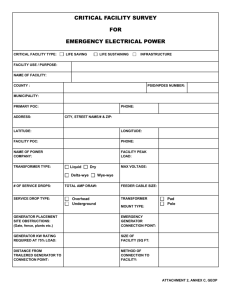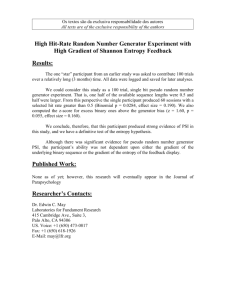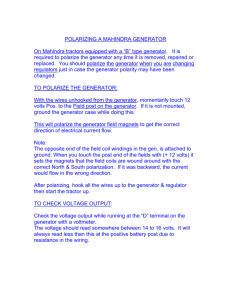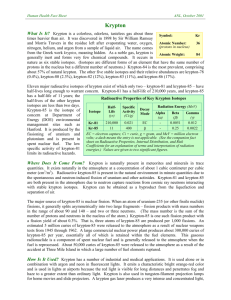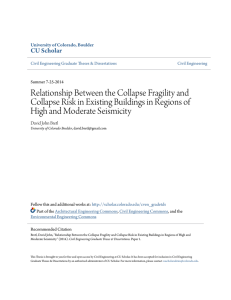DK R 1118 - Produktresume.dk
advertisement
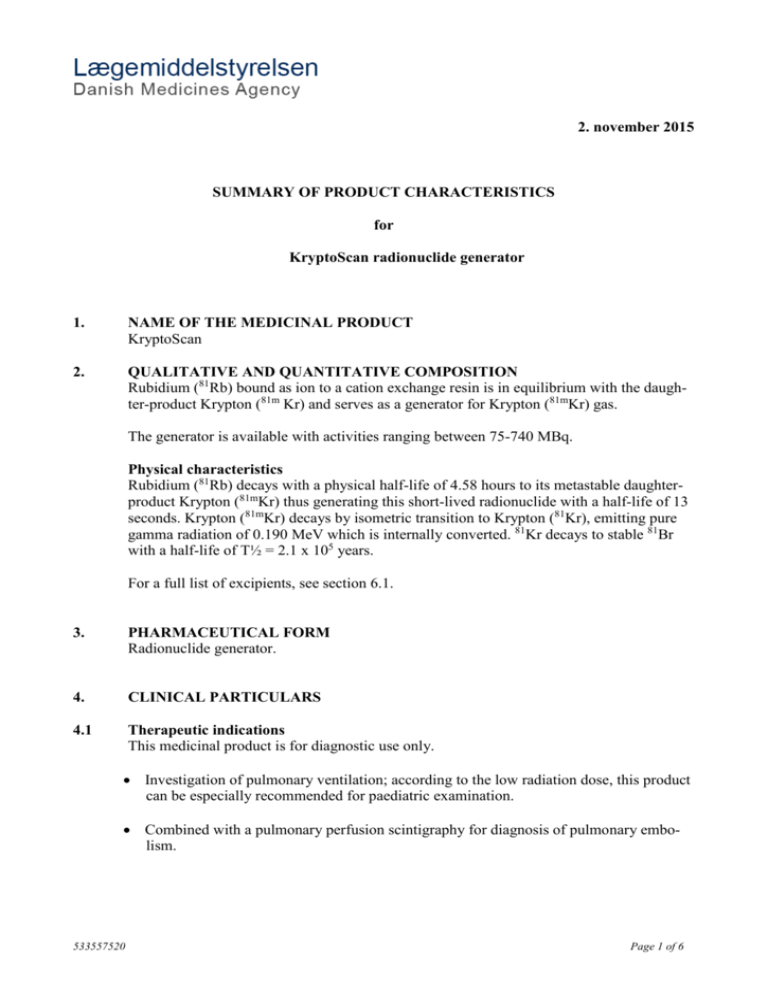
2. november 2015 SUMMARY OF PRODUCT CHARACTERISTICS for KryptoScan radionuclide generator 1. NAME OF THE MEDICINAL PRODUCT KryptoScan 2. QUALITATIVE AND QUANTITATIVE COMPOSITION Rubidium (81Rb) bound as ion to a cation exchange resin is in equilibrium with the daughter-product Krypton (81m Kr) and serves as a generator for Krypton (81mKr) gas. The generator is available with activities ranging between 75-740 MBq. Physical characteristics Rubidium (81Rb) decays with a physical half-life of 4.58 hours to its metastable daughterproduct Krypton (81mKr) thus generating this short-lived radionuclide with a half-life of 13 seconds. Krypton (81mKr) decays by isometric transition to Krypton (81Kr), emitting pure gamma radiation of 0.190 MeV which is internally converted. 81Kr decays to stable 81Br with a half-life of T½ = 2.1 x 105 years. For a full list of excipients, see section 6.1. 3. PHARMACEUTICAL FORM Radionuclide generator. 4. CLINICAL PARTICULARS 4.1 Therapeutic indications This medicinal product is for diagnostic use only. Investigation of pulmonary ventilation; according to the low radiation dose, this product can be especially recommended for paediatric examination. Combined with a pulmonary perfusion scintigraphy for diagnosis of pulmonary embolism. 533557520 Page 1 of 6 Pulmonary ventilation (81mKr) / perfusion (99Tc-macroaggregation) studies are possible because of the different spectrometric windows of 81mKr and 99mTc. 4.2 Posology and method of administration Krypton images are acquired during the continuous inhalation of the short lived and otherwise inert radioactive gas, Krypton (81mKr). This is eluted with humidified air from a rubidium generator and administered to the patient through a face mask or airway. In general adequate imaging is achieved when 200.000-350.000 counts are accumulated per gamma camera image. This corresponds to approx. 18 MBq/kg body weight. Most investigation requires a number of views = 4 to 6. The activities for children may be calculated according to the following equation: Activity-child (MBq) = Activity-adult (MBq) x body weight (kg) 70 (kg) Continuous inhalation is stopped upon acquisition of approx. 300.000 counts per gamma camera image. 4.3 Contraindications Hypersensitivity to the active substance or to any of the excipients. 4.4 Special warnings and precautions for use There are no specific warnings or precautions for use for this radiopharmaceutical product. 4.5 Interaction with other medicinal products and other forms of interaction Diazepam in sedative doses and general anaesthetic agents may affect the distribution of radioactive gases in the lung by slightly shifting the activity to the lung apex and reducing basal accumulation. 4.6 Pregnancy and lactation Pregnancy Only imperative investigations should be carried out during pregnancy, when the likely benefit exceeds the risk incurred by mother and foetus. Radionuclide procedures carried out on pregnant women also involve radiation doses to the foetus. When it is necessary to administer radioactive medicinal product to women of childbearing potential, information should always be sought about pregnancy. Any woman who has missed a period should be assumed to be pregnant until proven otherwise. Where uncertainty exists it is important that radiation exposure should be the minimum consistent with achieving the desired clinical information. Alternative techniques which do not involve ionising radiation should be considered. Lactation If it is necessary to administer krypton (81mKr) inhalation gas to a mother who is breastfeeding, the woman should not breastfeed until the investigation is over. If the woman also is administered with (99mTc), the period of time before which breastfeeding can recommence (due to accumulation of radioactivity in the breast milk) depends on the amount of (99mTc) given. 533557520 Page 2 of 6 4.7 Effects on ability to drive and use machines No studies on the effects on the ability to drive and use machines have been performed. 4.8 Undesirable effects No adverse/undesirable effects have been reported for this agent. For each patient, exposure to ionising radiation must be justifiable on the basis of likely clinical benefit. The activity administered must be such that the resulting radiation dose is as low as reasonably achievable bearing in mind the need to obtain the intended diagnostic or therapeutic result. Exposure to ionising radiation is linked with cancer induction and a potential for development of hereditary defects. For diagnostic nuclear medicine investigations the current evidence suggests that these adverse effects will occur with negligible frequency because of the low radiation dose incurred. For diagnostic investigations using a nuclear medicine procedure the radiation dose delivered (EDE) is less than 20 mSv. Higher doses may be justified in some clinical circumstances. Reporting of suspected adverse reactions Reporting suspected adverse reactions after authorisation of the medicinal product is important. It allows continued monitoring of the benefit/risk balance of the medicinal product. Healthcare professionals are asked to report any suspected adverse reactions via Lægemiddelstyrelsen Axel Heides Gade 1 DK-2300 København S Websted: www.meldenbivirkning.dk E-mail: dkma@dkma.dk 4.9 Overdose In the unlikely event of radiation overdose caused by a prolonged period of krypton gas inhalation, patients need only be removed from the source of radiation to a fresh and uncontaminated atmosphere. 5. PHARMACOLOGICAL PROPERTIES 5.1 Pharmacodynamic properties ATC code: V 09 EX 01 - Diagnostic radiopharmaceuticals, respiratory system. Krypton is an inert gas which is not metabolized and in the concentrations applied Krypton (81mKr) shows no pharmacodynamic effects. 5.2 Pharmacokinetic properties Krypton (81mKr) is an inert gas with a short biological half-life. Due to its rapid decay the effective half-time of lung elimination is equal to the physical half-life of 13 seconds. Peripheral Krypton (81mKr) -activity is exhaled after the first passage. 5.3 Preclinical safety data No data available. 533557520 Page 3 of 6 6. PHARMACEUTICAL PARTICULARS 6.1 List of excipients PTFE (polytetrafluoroethylene) membrane with immobilized poly (styrenedivinylbenzene) cation exchange resin with sulphonic acid functional groups. 6.2 Incompatibilities None known. 6.3 Shelf life The shelf life of the product is 20 hours after activity reference date. The expiry date is stated on the generator label. 6.4 Special precautions for storage Store below 25° C. Use a lead shielding. Storage should be in accordance with the national regulations for radioactive materials. 6.5 Nature and contents of container The radionuclide generator contains the mother-radionuclide 81Rb immobilized on a membrane. The daughter-radionuclide 81mKr is eluted by passing environmental air over the membrane. The produced gas from the generator contains therefore the radionuclide 81mKr mixed with environmental air. The generator containing 81mKr is placed in a lexan housing and then in a shielding. The shielding is fixed within a synthetic housing. 6.6 Special precautions for disposal and other handling Handling of the expired generator 1. Replace the stopper that was removed earlier. 2. Store the generator in a suitable place for decay until a level of activity acceptable for return transport is reached. 3. Prepare the generator for return transport following the return procedure. NB: In case of problems or other issues please consult your local representative. Any unused product or waste material should be disposed of in accordance with local requirements. The administration of radiopharmaceuticals creates risks for other persons from external radiation or contamination from spills of urine, vomiting etc. Radiation protection precautions in accordance with national regulations must therefore be taken. 7. 533557520 MARKETING AUTHORISATION HOLDER Mallinckrodt Medical B.V. Westerduinweg 3 1755 LE Petten The Netherlands Page 4 of 6 8. MARKETING AUTHORISATION NUMBER DK R 1118 9. DATE OF FIRST AUTHORISATION 31. January 1995 10. DATE OF REVISION OF THE TEXT 2. november 2015 11. DOSIMETRY Data from ICRP publication 53 (Vol.18; No 1-4, 1987) "radiation dose to patients from radiopharmaceuticals". Absorbed dose per unit activity administered (mGy/MBq) ICRP 53. Organ Adrenals Bladder wall Bone surfaces Breast GI-tract: Stomach wall Small intest ULI wall LLI wall Adult 3.4E-06 6.8E-08 1.7E-06 4.6E-06 15 year 5.7E-06 7.6E-08 2.2E-06 4.6E-06 10 year 8.3E-06 2.0E-07 3.2E-06 8.9E-06 5 year 1.3E-05 4.7E-07 4.8E-06 1.3E-05 1 year 2.1E-05 1.2E-06 9.3E-06 1.8E-05 2.5E-06 2.7E-07 3.2E-07 1.4E-07 3.2E-06 4.7E-07 5.5E-07 1.5E-07 4.4E-06 8.6E-07 1.2E-06 3.0E-07 6.7E-06 1.6E-06 1.9E-06 8.0E-07 1.1E-05 3.4E-06 3.5E-06 2.0E-06 Kidneys Liver Lungs Ovaries Pancreas 1.2E-06 3.4E-06 2.1E-04 1.7E-07 3.5E-06 1.9E-06 4.8E-06 3.1E-04 1.7E-07 4.4E-06 2.9E-06 6.6E-06 4.4E-04 4.1E-07 6.4E-06 4.5E-06 9.5E-06 6.8E-04 8.0E-07 9.8E-06 8.4E-06 1.6E-05 1.3E-03 1.9E-06 1.8E-05 Red marrow Spleen Testes Thyroid Uterus 2.1E-06 3.1E-06 1.7E-08 1.2E-06 1.3E-07 3.3E-06 4.1E-06 2.3E-08 2.1E-06 1.8E-07 4.2E-06 6.0E-06 7.4E-08 3.7E-06 3.5E-07 5.3E-06 9.2E-06 1.3E-08 6.0E-06 7.2E-07 8.2E-06 1.6E-05 5.6E-07 1.1E-05 1.8E-06 Other tissue Effective dose equivalent (mSv/MBq) 1.8E-06 2.3E-06 3.2E-06 4.7E-06 8.5E-06 2.7E-05 4.0E-05 5.7E-05 8.8E-05 1.7E-04 For this product the effective doses equivalent resulting from an administered activity of 3000-9000 MBq, (range of actual exposure) expected activities in adults, is 0.08-0.24 mSv. 533557520 Page 5 of 6 Due to the difference in half-lives the amount of 81Kr per 37 MBq, 81mKr is about 2 nCi (2 Bq/MBq). Thus the contribution of 81Kr to the total radiation burden of the patient is negligible. 12. INSTRUCTIONS FOR PREPARATION OF RADIOPHARMACEUTICALS Preparation for elution 1. Remove the Krypton (81mKr) generator from the transport packing. 2. Remove the stopper from the bottom and store it in the special cutaway in the transport packing. 3. Place the generator in the ventilation device. 4. Close the cover of the Krypton ventilation device. 5. Take the Krypton supply cable from the ventilation tubing set and connect it to the Krypton ventilation device. 6. Connect the other side of the tubing set to the face mask. 7. Put the plug into a socket. 8. Adjust flow rate to the maximum volume. Administration 1 Position the patient in front of the gamma camera (equipped with a 99mTc collimator). 2 Place the face mask on the face of the patient; make sure that there is no leakage. 3 Switch on power manually or by remote control. 4 Start accumulation of counts and continue until the required number is reached. 5 Switch power off. Any unused product or waste material should be disposed of in accordance with local requirements. 533557520 Page 6 of 6
